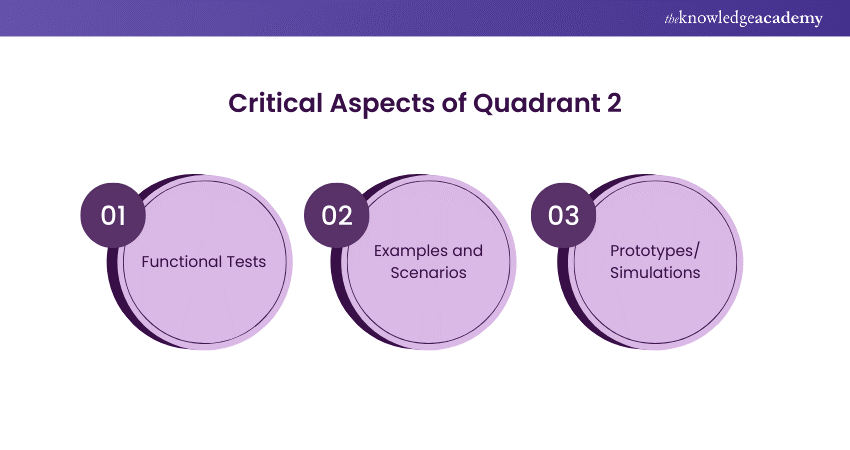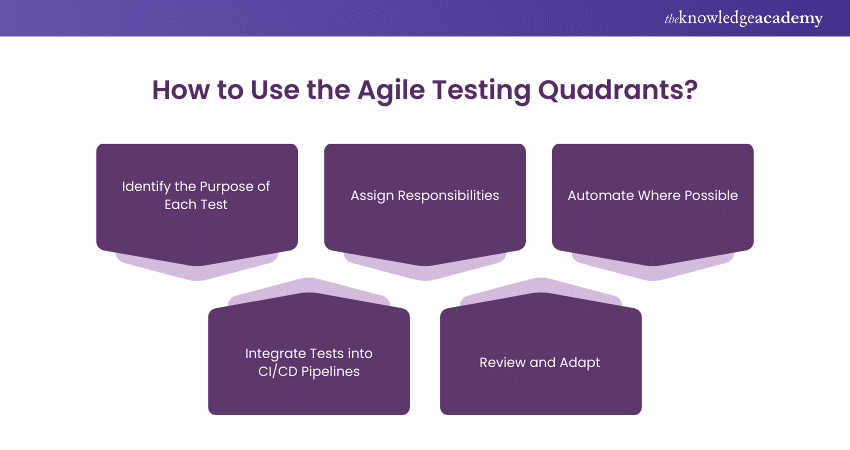We may not have the course you’re looking for. If you enquire or give us a call on +61 272026926 and speak to our training experts, we may still be able to help with your training requirements.
Training Outcomes Within Your Budget!
We ensure quality, budget-alignment, and timely delivery by our expert instructors.

Software development companies often face challenges in meeting tight deadlines. To maintain high-quality work, they must employ effective Software Testing techniques. Agile Testing Quadrants are one such technique that helps streamline the testing process. This model uses four quadrants to evaluate the user's experience with detailed testing. This blog explores Agile Testing Quadrants in detail and provides insights on how companies integrate them in agile workflow. So, without further ado, let’s get started.
Table of Contents
1) What are Agile Testing Quadrants?
a) Quadrant 1
b) Quadrant 2
c) Quadrant 3
d) Quadrant 4
2) How to Use the Agile Testing Quadrants?
3) Examples of Agile Testing Quadrants
4) Conclusion
What are Agile Testing Quadrants?
Agile Testing Quadrants offer a complete structure for understanding and organising different testing tasks in agile development. Brian Marick created them to help teams cover all testing angles, ranging from influencing development to customer evaluation. Dividing tests into four groups helps the tester understand what they are testing, what tools they need, and who is supposed to conduct that test easily.
1) Quadrant 1
Quadrant 1 is focused on tests that aid in the development process, also referred to as technology-facing tests that direct development. These tests are usually automated. Its main goal is to concentrate on confirming the code's functionality at a detailed level. Here are some critical aspects of it:
Critical Aspects of Quadrant 1:
1) Unit Tests: Automated tests written by developers to ensure that individual components or functions of the software operate correctly. These tests are executed frequently to catch defects early in the development cycle.
2) Component Tests: Like unit tests, component tests verify the behaviour of larger software sections, often integrating multiple units.
3) Test-Driven Development (TDD): A practice that involves writing tests before the actual code, ensuring that the codebase remains robust, and defects are quickly identified.
2) Quadrant 2
Quadrant 2 is centred on tests for the business that steer development. These tests ensure the software meets the needs of the industry. Quadrant 2 focuses on tests related to development. This is how stakeholders receive value addition. Here are some critical aspects of it:

Critical Aspects of Quadrant 2:
1) Functional Tests: These tests verify that the software behaves as expected from an end-user perspective. They are often manual but can be automated to validate user stories and acceptance criteria.
2) Examples and Scenarios: Business analysts and testers create examples and scenarios to illustrate how the software should perform in different situations, helping to clarify requirements and guide development.
3) Prototypes/Simulations: Early models or simulations of the software used to gather feedback from stakeholders, ensuring the development is aligned with business goals.
3) Quadrant 3
Quadrant 3 focuses on testing that examines the product from a business perspective. These tests are mainly manual and aim to verify that the software meets business requirements. It also delivers a satisfactory user experience (UX). Here are some critical aspects of it:
Critical Aspects of Quadrant 3:
1) Exploratory Testing: Testers actively explore the software to identify defects, focusing on areas that automated tests might miss. This type of testing relies on the tester’s experience and intuition.
2) Usability Testing: This involves assessing the software’s user interface (UI) and overall user experience (UX). Testers gather feedback from actual users to identify any issues affecting usability.
3) Alpha/Beta Testing: Pre-release versions of the software are distributed to a limited audience to identify any remaining defects and gather user feedback before the final release.
4) Quadrant 4
Quadrant 4 includes tests focused on technology that evaluate the quality of the product from a technical point of view. These assessments are usually done automatically. It concentrates on the software's non-functional characteristics. Here are some critical aspects of it:
Critical Aspects of Quadrant 4:
1) Performance Testing: This involves assessing the software’s performance under various conditions, such as load testing, to ensure it can handle expected user traffic.
2) Security Testing: These tests identify and address vulnerabilities in the software, ensuring its security against potential threats.
3) Compatibility Testing: This ensures the software functions correctly across different devices, browsers, and operating systems.
Advance your career with Agile Software Testing Training. Join today and gain mastery in Agile testing techniques!
How to Use the Agile Testing Quadrants?
Using the Agile Testing Quadrants involves strategically integrating the various tests into the development process. Let's know some of the steps to use these quadrants effectively:

1) Identify the Purpose of Each Test: Determine whether a test is meant to guide development (Quadrants 1 and 2) or evaluate the product (Quadrants 3 and 4).
2) Assign Responsibilities: Clarify who will be responsible for each type of test. Developers typically handle technology-facing tests, while testers and Business analysts focus on business-facing tests.
3) Automate Where Possible: Automate repetitive and reversal tests to save time and ensure consistency. Focus on manual testing for exploratory and usability aspects.
4) Integrate Tests into CI/CD Pipelines: Combine automated tests into continuous integration and delivery pipelines to catch defects early and ensure a smooth delivery process.
5) Review and Adapt: Regularly review the testing strategy and adapt as required based on feedback and changing project requirements.
Become a master of Agile Software Testing with our Agile Tester Training- Sign up now!
Examples of Agile Testing Quadrants
Examples show how these quadrants get applied in the real world to streamline testing. Let’s see it for two major platforms here:
E-commerce Platform
Agile Testing Quadrant ensure rigid functionality through shopping cart feature and performance tests. Exploratory testing strategies can improve user experience (UX). In an e-commerce platform, Agile Testing Quadrants can be applied as follows:
a) Quadrant 1: Developers write unit tests for components like the shopping cart, product listings, and payment processing.
b) Quadrant 2: Checking out the functionality, user registration, and product search are what functional tests verify.
c) Quadrant 3: During testing, exploratory testers find what's wrong in the user journey while ensuring that it is quite easy for anyone to use the interface by usability testing
d) Quadrant 4: Performance tests ensure the platform can handle high traffic during sales events, and security tests protect against vulnerabilities like SQL injection and cross-site scripting.
Initial Development Stages
Agile Testing perform unit tests to clarify requirements. Business goals are met with effective development procedures. During the initial development stages of a project, the focus might be more on Quadrants 1 and 2:
a) Quadrant 1: Developers use TDD to write unit and component tests as they develop new features.
b) Quadrant 2: Business analysts create scenarios and examples to clarify requirements and guide development.
c) Quadrant 3: As the project progresses, testers begin exploratory testing to identify any emerging issues.
d) Quadrant 4: Performance and security tests are planned and executed as the software becomes more stable and ready for release.
Conclusion
We hope you understand Agile Testing Quadrants well. This model offers a structured process for testing in agile development, ensuring all software elements are thoroughly tested. It splits testing activities into four quadrants. Integrating these quadrants into the agile workflow enhances the overall quality of the software. Thus, delivering value to stakeholders.
Take your skills to the next level with Agile Software Testing Training Course. Register now and excel in Agile testing!
Frequently Asked Questions

The testing quadrants provide a clear framework for categorising and understanding different testing activities. This helps teams ensure comprehensive coverage, identify responsibilities, and efficiently integrate testing into the development process.

Agile testing levels refer to the agile development process's various phases. These levels include unit testing, integration testing, system testing, and acceptance testing. Each level works on different software elements, from individual components to the entire system. It ensures complete quality assurance (QA).

The Knowledge Academy takes global learning to new heights, offering over 30,000 online courses across 490+ locations in 220 countries. This expansive reach ensures accessibility and convenience for learners worldwide.
Alongside our diverse Online Course Catalogue, encompassing 17 major categories, we go the extra mile by providing a plethora of free educational Online Resources like News updates, Blogs, videos, webinars, and interview questions. Tailoring learning experiences further, professionals can maximise value with customisable Course Bundles of TKA.

The Knowledge Academy’s Knowledge Pass, a prepaid voucher, adds another layer of flexibility, allowing course bookings over a 12-month period. Join us on a journey where education knows no bounds.

The Knowledge Academy offers various Agile Software Testing Training, including Agile Software Testing Course, ISTQB Software Testing Foundation and Software Testing Black Belt. These courses cater to different skill levels and provide comprehensive insights into What is Agile Software Development.
Our Business Analysis Blogs cover a range of topics related to Business Analysis, offering valuable resources, best practices, and industry insights. Whether you are a beginner or looking to advance your Business Analysis skills, The Knowledge Academy's diverse courses and informative blogs have got you covered.







 Top Rated Course
Top Rated Course




 If you wish to make any changes to your course, please
If you wish to make any changes to your course, please


